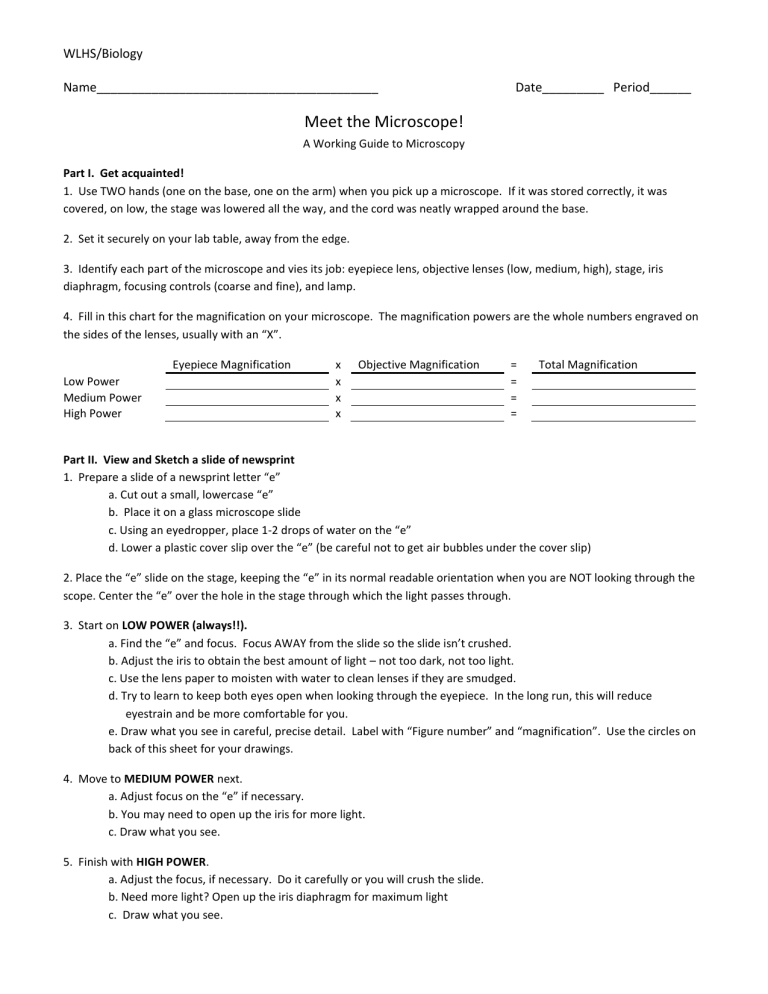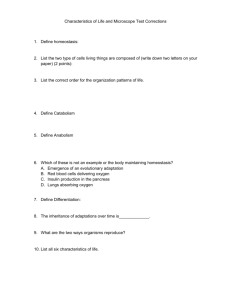Name_________________________________________

WLHS/Biology
Name_________________________________________ Date_________ Period______
Meet the Microscope!
A Working Guide to Microscopy
Part I. Get acquainted!
1. Use TWO hands (one on the base, one on the arm) when you pick up a microscope. If it was stored correctly, it was covered, on low, the stage was lowered all the way, and the cord was neatly wrapped around the base.
2. Set it securely on your lab table, away from the edge.
3. Identify each part of the microscope and vies its job: eyepiece lens, objective lenses (low, medium, high), stage, iris diaphragm, focusing controls (coarse and fine), and lamp.
4. Fill in this chart for the magnification on your microscope. The magnification powers are the whole numbers engraved on the sides of the lenses, usually with an “X”.
Low Power
Medium Power
High Power
Eyepiece Magnification x Objective Magnification x x x
= Total Magnification
=
=
=
Part II. View and Sketch a slide of newsprint
1. Prepare a slide of a newsprint letter “e” a. Cut out a small, lowercase “e” b. Place it on a glass microscope slide c. Using an eyedropper, place 1-2 drops of water on the “e” d. Lower a plastic cover slip over the “e” (be careful not to get air bubbles under the cover slip)
2. Place the “e” slide on the stage, keeping the “e” in its normal readable orientation when you are NOT looking through the scope. Center the “e” over the hole in the stage through which the light passes through.
3. Start on LOW POWER (always!!). a. Find the “e” and focus. Focus AWAY from the slide so the slide isn’t crushed. b. Adjust the iris to obtain the best amount of light – not too dark, not too light. c. Use the lens paper to moisten with water to clean lenses if they are smudged. d. Try to learn to keep both eyes open when looking through the eyepiece. In the long run, this will reduce
eyestrain and be more comfortable for you. e. Draw what you see in careful, precise detail. Label with “Figure number” and “magnification”. Use the circles on back of this sheet for your drawings.
4. Move to MEDIUM POWER next. a. Adjust focus on the “e” if necessary. b. You may need to open up the iris for more light. c. Draw what you see.
5. Finish with HIGH POWER. a. Adjust the focus, if necessary. Do it carefully or you will crush the slide. b. Need more light? Open up the iris diaphragm for maximum light c. Draw what you see.
WLHS/Biology
Part III. What to do after using the scope a. Lower stage to bottom b. Objective lens should be at the lowest power c. There should be no slides on the stage. d. Wrap the cord neatly around the base. e. Put cover over microscope.
***Have your teacher sign this line to receive credit for putting away microscope correctly_______***
Microscope Post-lab Questions
1. How is the image of an object seen through the high-power objective lens from the image seen through the low-power objective lens?
2. How does the letter “e” as seen through the microscope differ from the way an “e” normally appears?
3. When you move the slide to the left, in what direction does the image appear to move?
4. Explain why a specimen to be viewed under the microscope must be thin.
5. Suppose you were observing an organism through a microscope and noticed that it moved toward the bottom of the slide and then it moved to the right. Describe the actual movement of the organism.
Use the circles below to draw what you see under the various magnifications. Make sure to label and give the magnification for each viewing.




